You’re looking to buy a generator, but you’re unsure about the right size for your needs? Don’t worry; you’re not alone.
This guide will help you understand generator sizing, evaluate your power needs, explore various types of generators, and select the appropriate model.
Plus, we’ve included maintenance tips to ensure your generator’s longevity.
Let’s dive in and put you on the path to making an informed decision.
Understanding Generator Sizing

To get your head around generator sizing, you’ve got to understand that it’s all about matching the power output of the generator with your specific energy needs. You can’t just pick any model off the shelf. It’s a process that requires a detailed analysis of the electrical loads you intend to power.
You’ve got to list down all your appliances, determine their starting and running wattage, and calculate your total power requirement. You also need to consider the generator’s power rating, which is measured in kilowatts (kW).
It’s crucial to choose a generator that can supply more than your total power requirement to accommodate for possible future additions, and to ensure you’re not overloading the generator. Remember, precision in sizing is key for efficient generator performance.
Evaluating Your Power Needs
How do you accurately evaluate your power needs for the right generator?
You’ll need to conduct a comprehensive power audit.
This involves tallying up the total wattage of all appliances and equipment you aim to power. Remember, some devices have a ‘starting wattage’ higher than their ‘running wattage’, so account for this surge.
Make a list, detailing each item’s wattage, and add them up. Don’t overlook less obvious power consumers like HVAC and lighting.
If you’re unsure of the wattage, reference the manufacturer’s guidelines or use a wattage estimation chart.
Once you’ve determined your total power usage, you’ll have a clear idea of the generator size you need. But always allow some headroom for unforeseen additions or upgrades.
Types of Generators Explained
After taking the time to determine your power needs, you’re now ready to explore the different types of generators available.
Firstly, there’s the standby generator, intended for home use. This type automatically kicks in when there’s a power outage.
Portable generators, on the other hand, are more versatile and can be moved around.
Inverter generators are a newer technology. They’re more fuel-efficient and produce cleaner power, which is safe for sensitive electronics.

Lastly, there are industrial generators, used for large-scale applications like factories or hospitals.
Each has its advantages and limitations. The choice will ultimately be influenced by factors such as the amount of power needed, the application, and your budget.
Selecting the Appropriate Model
Once you’ve familiarized yourself with the various types of generators, it’s time to select the model that best suits your power needs and budget. Consider the wattage requirements of your essential appliances and calculate your total power needs.
Portable generators are ideal for occasional use and cover basic needs, while standby generators provide a higher power output for larger properties or businesses.
Don’t forget to account for fuel efficiency and maintenance costs. Look for a model with a long run-time and low fuel consumption. It’s also crucial to ensure the generator’s noise level is appropriate for your setting.
Lastly, check for safety features like automatic shutdown on overload. Ultimately, your choice should balance power capacity, cost, and convenience.
Maintenance Tips for Longevity
Now that you’ve chosen the right generator model, it’s crucial to keep it running smoothly with proper maintenance for its longevity. Regularly inspect the oil level; a low level can cause overheating and damage the engine. Change the oil after the first 20 hours of use, then every 100 hours or annually, whichever comes first.
Keep the air filter clean; a clogged filter restricts airflow, reducing efficiency and increasing fuel consumption. Check your fuel system periodically for leaks or damage. Ensure the generator is grounded correctly to avoid electrical shocks.
Lastly, don’t forget to run your generator at least once a month. This helps lubricate the engine and prevents the carburetor from gumming up. Proper maintenance will ensure optimal performance and a longer lifespan for your generator.

Conclusion
Choosing the right generator size doesn’t have to be complicated.
First, understand your power needs by assessing your appliances’ wattage.
Then, familiarize yourself with different generator types and their capacities.
Choose a model that suits your needs, and don’t forget regular maintenance for longevity.
Remember, a well-selected generator not only provides power backup, but also safeguards your valuable appliances from power fluctuations.
